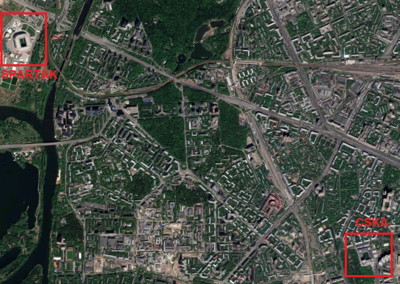 Though Russia is technically a country, it’s far more correct to think of it is a wide-ranging continent. It’s common to imagine the entirety of Russia to be a snow covered landscape filled with people drinking vodka and covered in bear-skins, but that does an immense disservice to one of the most diverse nations on earth.
Though Russia is technically a country, it’s far more correct to think of it is a wide-ranging continent. It’s common to imagine the entirety of Russia to be a snow covered landscape filled with people drinking vodka and covered in bear-skins, but that does an immense disservice to one of the most diverse nations on earth.
Sochi, for example, where the Winter Olympics were held in 2014, can reach temperatures of over forty degrees Celsius. Russia ranges from the edge of Europe, near Belarus and Ukraine, over to the Far East. Of the entire nation, no city is as instantly recognisable as Moscow. The capital of the country, it is also the most populous, with more than twelve million people living within the city and a further seventeen million plus living in the urban areas on its outskirts.
It’s as populous as it is because it is the political, cultural, economic and even scientific centre of both Russia and the entire East of Europe. It’s one of the largest cities in the world and, according to Forbes Magazine back in 2013, the ninth most expensive. Those twenty-nine million plus people that live in the city and its outskirts need something to do in their spare time and whilst there are plenty of interesting places to check out, such as the Kremlin, Red Square and countless parks and museums, that’s not enough to feed a sports hungry city.
That might well explain why there are seven football clubs based in the city, with four of them being big enough to capture our attention and deserving of a write-up. There are another twenty-eight now defunct football clubs that have entertained the people of Moscow in years gone by too, proving, perhaps, that football has always been one of the city’s most loved past-times.
{module Maps – Cities – Moscow}
Football Stadiums in Moscow
| Stadium | Capacity | Team | League |
|---|---|---|---|
| Arena CSKA | 30,000 | PFC CSKA Moscow | Russian Premier League |
| Luzhniki Stadium | 81,000 | Russia | |
| Otkritie Arena | 45,360 | Spartak Moscow | Russian Premier League |
| RZD Arena | 27,084 | Locomotiv Moscow | Russian Premier League |
PFC CSKA Moscow – VEB ARENA (4.80 Miles to The Kremlin)
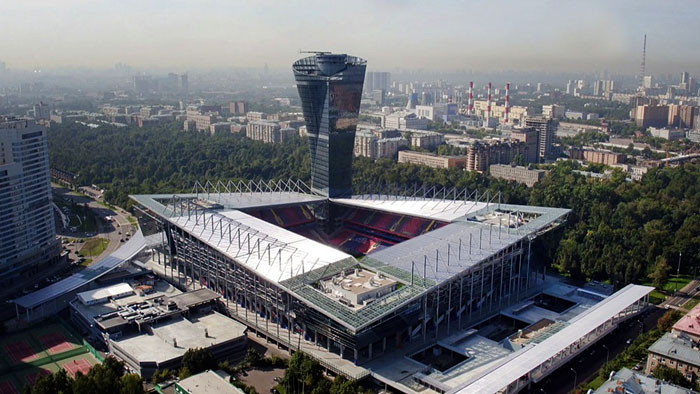
The PFC of CSKA Moscow simply stands for ‘Professional Football Club’, but it’s the meaning of the CSKA acronym that tells the true story of the team. That it translates to ‘Central Sport Club of the Army’ will likely give you all of the information that you need, having been formed in 1911 as part of the Russian Army under the title of ‘Amateur Society of Skiing Sports’. The current name was adopted in 1960 and has remained in place ever since. Though it’s technically no longer part of Russia’s military set-up, the Russian Ministry of Defence does still have shares in the club. It is Russian football’s oldest team and was the first to win a major European tournament, which it achieved in 2005 when it beat Sporting Lisbon in the UEFA Cup. CSKA have won thirteen top-flight titles to date, with seven of them coming when it was the Soviet Top League and six titles during the Russian Premier League era. They added five Soviet Cups and seven Russian Cups during those two periods in history, too.
As you’d expect for a Russian football club, there have been some fascinating moments during CSKA’s history. The official club of the Soviet Army back in the country’s overtly Communist period, they won the Soviet Championship in 1951 and started the following season with three wins out of three. However, they were made to withdraw from the league championship because of a poor showing from the Soviet Union’s football team during the Helsinki Olympics of 1952. This is the team that, perhaps more than any other, has always represented the Russian authorities. That might well explain why it’s not one of Russia’s most popular clubs, though it has received numerous sponsors and injections of cash over the years. Once such injection came about in 2004 when sponsorship was offered by Sibneft, the company owned by Chelsea owner and friend of Vladimir Putin, Roman Abramovich.
In terms of stadiums, CSKA actually have one named the Light-Athletic Football Complex CSKA. That only has room for less than five-thousand people, however, so most of their matches have been played over the years in venues throughout the city. One such ground was the Grigory Fedotov Stadium, where they played between 1961 and 2000. That was demolished in 2007, with work starting on Arena CSKA. Whilst the new ground was being built the club played matches at both Arena Khimki and Luzhniki Stadium, with Arena CSKA opening in September of 2016. It became VEB Arena in February of the following year, thanks to a sponsorship deal with Vnesheconombank, or VEB for short.
FC Dynamo Moscow – VTB Arena (3.53 Miles to The Kremlin)
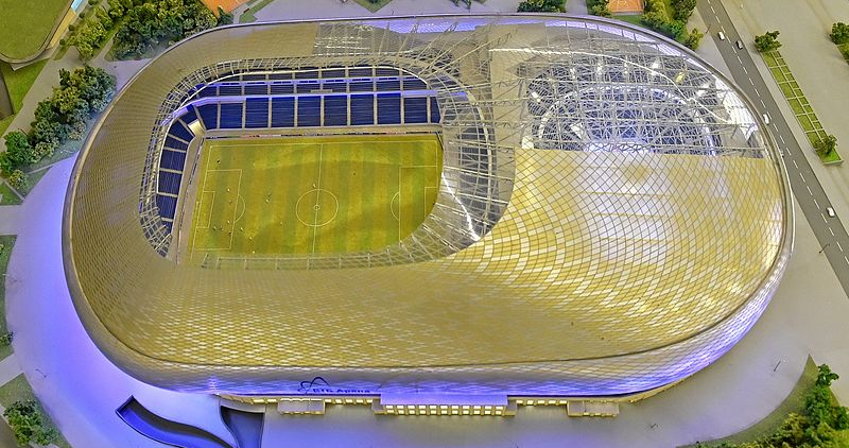
Dynamo Moscow are an interesting football club, thanks in part to the fact that they were an ever present in the top-flight of Russian football until 2016 but have never won the title. Though CSKA Moscow is technically the oldest football club in the country, that’s only because others have been shut down or adapted into other teams. One example of this comes in the form of Dynamo Moscow, that can trace its roots back the a club named Morozovtsi Orekhovo-Zuevo Moskva, which was formed in 1887 as a factory team. It was renamed in 1906 to OKS Moskva and in the wake of the Russian Revolution was taken under the wings of the Interior Ministry. It was in 1923 that it took on its current moniker, though opposition supporters referred to it as ‘garbage’, which is a slang term for the police, owing to its connections with the Interior Ministry. Indeed, throughout the Soviet Era it was linked to both the MVD and the KGB, making it one of the least popular of Russian teams.
Ever since it was formed, Dynamo Moscow has had its biggest rivalry with Spartak Moscow. There’s an extent to which this is because Dynamo’s first-ever league title came at the expense of Spartak, when they bear them 1-0 at Dynamo Stadium in 1936. In recent years, as Dynamo’s fortunes have waned, the rivalry has become less hostile and seen as less important. The club has won eleven top-flight titles over the years, but their last one came in 1976. They’ve faired slightly better in terms of the Soviet Cup, now called the Russian Cup, in recent times, having won it seven times in total and their last one in 1995. They haven’t won a European trophy to date, though they did finish as runners-up in the UEFA Cup Winners’ Cup in 1972, losing 3-2 to Scottish side Glasgow Rangers.
For most of the club’s existence, they played their games in Dynamo Stadium, which is located in the Petrovsky Park area of the city. That could house more than thirty-six and a half thousand supporters but was closed for demolition back in 2008. From 2010 they began sharing Arena Khimki with CSKA Moscow, up until CSKA Arena opened and they then had it all to themselves. That was whilst they were waiting for VTB Arena to open, which was built on the site of Dynamo Stadium. A much smaller venue, it can house about twenty-six thousand supporters for football but is adjoined to a smaller indoor arena. That can welcome eleven thousand people for ice hockey and thirteen thousand for events such as MMA bouts and musical concerts. It was included on the list of venues that Russia hoped to use when it hosted the 2018 FIFA World Cup, but in the end the Otkrytie Arena was favoured over it.
FC Lokomotiv Moscow – RZD Arena (5.94 Miles to The Kremlin)
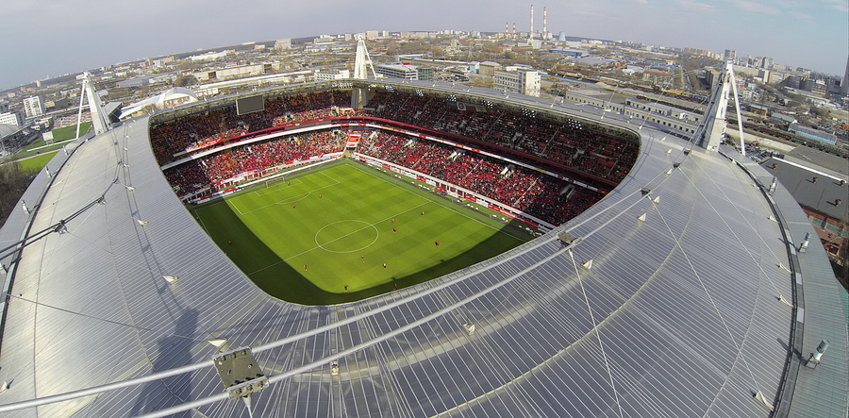
Founded as Kazanka in 1922, Lokomotiv Moscow took on its current title in 1936. When Russia was under Communist rule, Lokomotiv was part of the Lokomotiv Voluntary Sports Society and the Soviet Ministry of Transportation owned it. The club picked up its first silverware the same year it got its name, when it won the 1936 Soviet Cup. Since then it has picked up eight more Soviet Cups / Russian Cups, with the most recent coming in 2017. They’ve won the top-flight twice, in 2002 and 2004, though they’ve finished as runners-up on five separate occasions. The club was one of the first Russian teams to be allowed to play against foreign opposition, being seen as something of an ambassador side for Russian football after being allowed to play friendly matches against other side from 1955 onwards. When the Soviet Union broke up, Lokomotiv was considered to be one of Moscow’s weaker sides.
It was perhaps somewhat ironic that Lokomotiv’s detractors believed them to be weak, given that the other major teams in the capital city all had state sponsors that essentially disappeared with the collapse of Soviet era Russia. They put together some excellent performances in both the domestic league and the European Cup, leading to them gaining new supporters and having to completely redevelop their ground. The new Lokomotiv Stadium opened in 2002, leading to a steady increase in supporters attending their matches and meaning that by 2009 the club boasted the second-highest attendance rates in the city. The ground has room for just shy of twenty-nine thousand supporters, with all of the seats being covered.
Prior to the club’s success after the turn of the millennium, the side was known as the ‘fifth wheel of the Moscow cart’, thanks to Torpedo Moscow considered to be more relevant than them. That all changed when Lokomotiv won their first title, especially because of the manner in which they did it. Having finished on the same number of points as CSKA Moscow after thirty games, the two teams needed to play what was called a ‘Golden Match’ to decide upon who would be the winner of the Russian League. Can you imagine Manchester City and Manchester United, or Arsenal and Tottenham Hotspur, having to play one match to decide upon the destination of the title? That’s what happened, with Lokomotiv’s captain, Dmitry Loskov, scoring the only goal of the game and giving the club its first title and creating something of a modern-day rivalry between the two teams.
FC Spartak Moscow – OTKRITIE ARENA (8.24 Miles to The Kremlin)
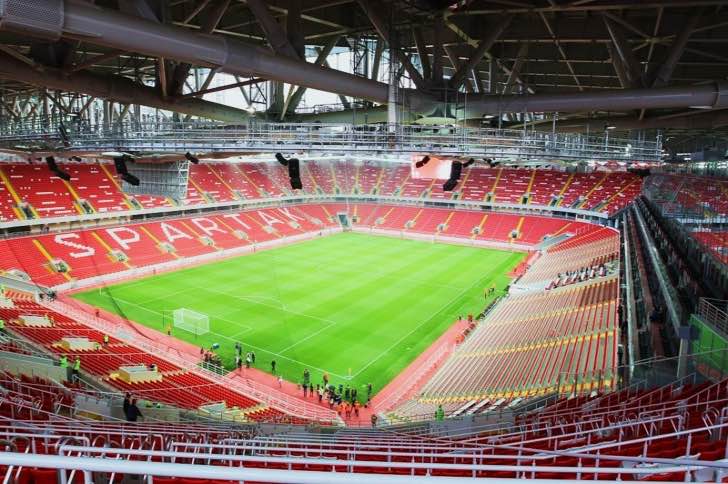
Save the best until last, as they say, which is what we’ve done with Spartak Moscow. The club is Russia’s most successful team, having won twelve Soviet championships and ten more since the country became Russia instead of the Soviet Union. Add to that ten Soviet Cups and three Russian Cups to date and you can start to see why the club has such a large following in the city. Another reason lies in the club’s origins, with most other football teams receiving patronage from official bodies. We’ve already told you about CSKA’s link to the Russian Army and Lokomotiv’s somewhat obvious association with the railway industry, whilst Dynamo had a strong link the Moscow police force. Spartak, however, was formed by a public trade union, leading it to be considered as the ‘people’s club’. Traditionally linked to the Spartak sports society, the football club aspect of the venture came about in 1922 and took on its current name in 1934.
It’s perhaps not entirely coincidental that the word ‘Spartak’ is a derivative of ‘Spartacus’, the gladiator-slave who fought back against the powers that be of Rome in order to lead a rebellion. It’s fascinating that a city with numerous football clubs that all have links to various authorities, the one that was formed by the people went on to be the most successful. In fact, between 1992 and 2001, Spartak won all but one of the newly formed Russian League’s titles. Despite regularly being the main Russian representative in the European Cup, now the Champions League, the furthest that Spartak have ever got in the competition is the semi-final; something that they achieved in 1991. Interestingly, they reached the same stage of both the UEFA Cup Winners’ Cup – in 1993 – and the UEFA Cup – in 1998. Probably the club’s biggest rivalry is with CSKA Moscow, given that the Army’s team represents the establishment of Russia and Spartak play for the people. When the two sides go head-to-head the game is known as the ‘Main Moscow Derby’.
Whether the powers that be in Moscow like it or not, Spartak are the most popular team in the city. This in spite of the fact that the club had never owned its own stadium until the opening of the Otkrytie Arena in 2014. In fact, they even once played an exhibition match in the middle of Red Square. Otkrytie Arena endured something of a troubled beginning, given that ground was broken on its construction in 2007 and was supposed to be completed by 2009. Instead, numerous delays caused issues and it didn’t open until five years later. As well as being able to welcome more than forty-five thousand people for football matches, the stadium can also host other sports if it needs to. It was used as one of the venues for the 2017 Confederations Cup as well as the 2018 FIFA World Cup. During the latter competition, Otkrytie Arena was the venue for the opening game of the tournament.
Russian National Side – LUZHNIKI STADIUM (3.12 Miles To Kremlin)
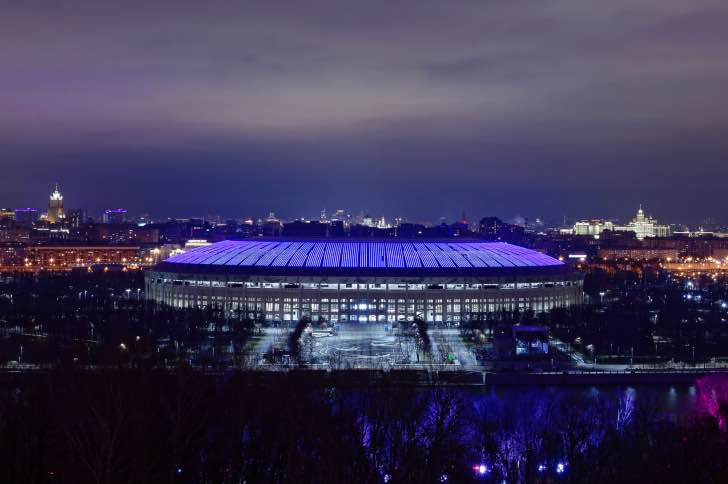
Ground was broken for the building of the Lulhniki Stadium in 1955, with the venue opening the following year. Back then it was known as the Central Lenin Stadium, keeping that name until it was rebranded with its current one in 1992. The UEFA Category 4 stadium has hosted UEFA Cup and Champions League finals, as well as the final of the World Cup when Russia hosted the tournament in 2018. Though no club calls it their home at present, it has been used by three of Moscow’s biggest sides at one point or another in the past. Each of Spartak Moscow, Torpedo Moscow and CSKA Moscow have moved in for a time.
The stadium was given a complete overhaul between 2013 and 2017, getting it ready for its job of host venue ahead of the 2018 World Cup. It’s very much considered to be the home of the Russian national side, therefore, and they very much out-performed expectations when they not only made it out of the group but proceeded all the way to the quarter-finals. In the end, it took Croatia penalties to be able to knock the hosts out and it is perhaps noteworthy that they put in their best performance of the tournament at the Luzhniki Stadium.
The stadium is located in the Central Administrative Okrug of the Khamovniki District, to the south-west of the centre of Moscow. The name comes from the flood meadows that are found in the bend of the River Moskva where the stadium stands. The choice of location was made because of the need to have a large area of land to house the national stadium, with the added convenience of nearby transport systems. It has had a permanent hybrid turf installed since 2016, which is mostly natural grass reinforced with plastic. It is a ground of cultural significance, having been used for events such as the Summer Olympics and major football cup finals.
